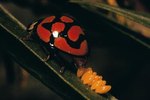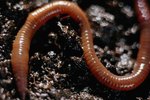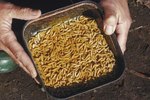
Earwigs are also known as pincher bugs, due to a distinctive tweezer-like apparatus on their abdomens. Earwigs are found around the globe, and despite their taste for flowers and plants, these tiny critters pose little harm. In fact, they're often considered beneficial insects, as they eat other insects.
Earwigs Are Everywhere
Earwigs are found around the world, and almost 2,000 species are known. The earwig's name derives from a European superstition that claimed these insects enter the ears of sleeping people and crawl into their brains. Earwigs are black, brown, reddish, tan or yellow in color, and can range from a quarter inch to over 1 inch in length. The earwig body is long, flat and separated into three sections, and is equipped with wings. Adults have pincers that they use to capture prey.
Moms Stay with Their Earwig Eggs
An earwig comes into the world as one of 50 to 80 eggs, which hatch in about two weeks. On average, one to two litters are produced per year. Mother earwigs stay with their eggs and nymphs for quite a while, sometimes until after their second molt; earwigs molt about five times throughout life. After they leave the nest, if they're not killed by toads, birds, beetles or other predators, they will live about one to three years.
Earwigs Eat Anything
Earwigs are omnivores, which means they will eat both plant and animal materials. They often dine on plants, flowers, leaves, other insects, moss, lichens, algae and fungi. They feed at night, and gravitate toward grass and woods as their preferred habitat. They are able to chew, which is handy for eating tough foods like insects. During the day they hide and rest under rocks, debris or other cover.
Earwigs Are Generally Harmless
Although their tweezer-like appendages—called forceps—may look scary, earwigs are generally harmless to people. The only risk they pose is the potential invasion of crops, flowers or other foliage or plantings. However, most earwig species are considered beneficial, as they feed on other insects. When they come inside, it is often by accident, and they generally do not reproduce indoors. If you find an earwig, placing it outside will benefit both of you.
References
Photo Credits
-
Brand X Pictures/Brand X Pictures/Getty Images
Writer Bio
Sarah Whitman's work has been featured in newspapers, magazines, websites and informational booklets. She is currently pursuing a master's degree in nutrition, and her projects feature nutrition and cooking, whole foods, supplements and organics. She also specializes in companion animal health, encouraging the use of whole foods, supplements and other holistic approaches to pet care.




